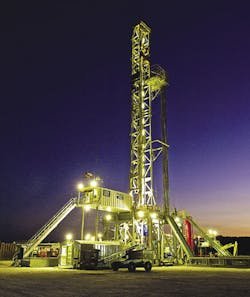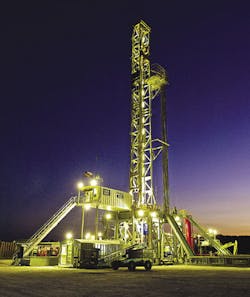ConocoPhillips ramps up Eagle Ford shale development
ConocoPhillips Corp. has raised its resource estimate in the Eagle Ford shale by 700 million bbl to 2.5 billion bbl of oil in place after pilot tests targeting shallower levels of the formation show the company's leasehold contains more oil than previously thought.
The majority of ConocoPhillips's wells in the South Texas play target the lower portion of the Lower Eagle Ford. But Matt Fox, executive vice-president of exploration and production, said the company has begun drilling wells in the upper portion of the Lower Eagle Ford with promising results.
"We are transitioning now to add another layer of wells in the upper part of the Lower Eagle Ford, and we have data from our pilot testing processes that tell us that they are going to drain different oil than the wells deeper in the Lower Eagle Ford," Fox told the company's annual analyst day in New York.
The company also plans to drill five wells to test the potential of the Upper Eagle Ford and Austin Chalk formations across its acreage this year. According to Fox: "We already know that the Austin Chalk works across some of our acreage, and we are trying to make sure we understand how widespread is that Austin Chalk potential."
Core asset
ConocoPhillips's Eagle Ford leasehold totals 221,000 net acres in South Texas, primarily in DeWitt, Karnes, and Live Oak counties. The Eagle Ford shale is considered one of ConocoPhillips's most promising developments. Al Hirshberg, executive vice-president of technology and projects, said development is accelerating.
This year, plans call for allocating $3 billion to the shale play, $1 billion more than 2013 spending levels and equivalent to 18% of the company's total projected capital spending budget of $16.7 billion. Spending is slated to hold steady at $3 billion/year through 2017.
ConocoPhillips last year focused on delineating its acreage and ensuring core leasehold was secured by production. Eleven rigs drilled 164 wells. More than 500 wells were online by yearend. This year, ConocoPhillips is transitioning into full-field development. The company is running 12 rigs and expects to bring about 190 wells online. Roughly 75% of wells will be drilled from multiwell pads.
Net production from the Eagle Ford rose 70% in 2013 to 119,000 boe/d and jumped in the first quarter of 2014 to 160,000 boe/d. ConocoPhillips expects output will exceed 250,000 boe/d by 2017.
New infrastructure is being developed to accommodate rising production, with an emphasis on liquids-handling capacity. ConocoPhillips operates three condensate stabilization plants in South Texas: the Helena and Bordovsky plants, near Kenedy, have 75,000 boe of combined processing capacity, and the Sugarloaf plant near Pawnee can process up to 15,000 boe/d. Capacity expansions are planned for the Helena and Sugarloaf plants this year.
Cost reduction
The company is also focused on cost reduction. Hirshberg said one new drilling technology that is saving money is the Drilling Execution Efficiency Platform. DEEP is a data-intensive, real-time methodology being tested by ConocoPhillips in the Eagle Ford.
"The way this works is we measure several key parameters along the length of the drillstring," Hishberg said. "In real time, we are crunching the data at the well site and then using that to control the top drive, control the speed of rotation of the drillstring and the weight on bit."
The technology allows ConocoPhillips to eliminate wasted energy in the drillstring and maximize the amount of energy that makes it to the drillbit. Hirshberg said DEEP has "led to 20% improvements in rate of penetration in the build and the horizontal sections of these unconventional wellbores."
ConocoPhillips has also installed an integrated operation center that gathers key operating data in real time using a field-wide wireless internet system. Live surveillance data enable ConocoPhillips to identify and focus on the most pressing issues each day. The central control room has enabled ConocoPhillips to reduce the amount of shut-in events recoded each quarter to nearly 0 from as high as 250. "It's pretty dramatic the impact that this has had," Hirshberg said.
Sweet spot
ConocoPhillips is optimistic about the potential of its leasehold. Fox said the company's acreage lies in the optimal thermal maturity window of the formation, in an area characterized by high pressure and thick reservoirs. He added: Eagle Ford rocks were laid down about 90 million years ago in the Cretaceous Interior Seaway. They are organic marrows that are rich in calcite and contain embedded organic material.
"You want to be in the parts of the Eagle Ford where you've got high calcite content so that it's very frackable and where you've got a lot of preserved organic material, so you've got a lot of oil in place," Fox said. "And that's where we are in the Eagle Ford, in the geologic sweet spot."

